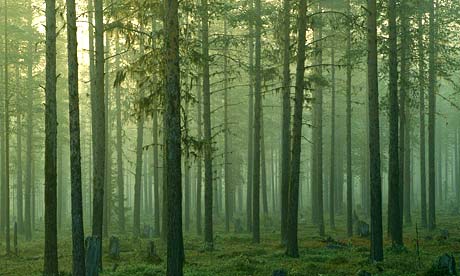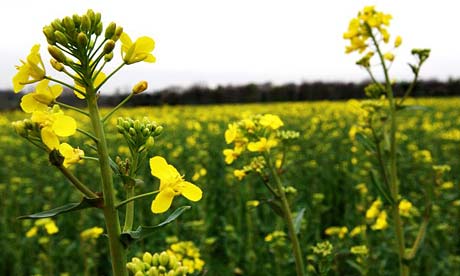· Shorter winters weaken forest 'carbon sinks'
· Data analysis reverses scientists' expectations

Forest managed for timber near Jokkmokk, Sweden. Photograph: Peter Essick/Aurora/Getty Images
The ability of forests to soak up man-made carbon dioxide is weakening, according to an analysis of two decades of data from more than 30 sites in the frozen north.
The finding published today is crucial, because it means that more of the CO2 we release will end up affecting the climate in the atmosphere rather than being safely locked away in trees or soil.
The results may partly explain recent studies suggesting that the amount of CO2 in the atmosphere is increasing faster than expected. If higher temperatures mean less carbon is soaked up by plants and microbes, global warming will accelerate.
The Intergovernmental Panel on Climate Change, which shared the Nobel peace prize with Al Gore, has concluded that humanity has eight years left to prevent the worst effects of global warming.
Carbon uptake by land and sea is crucial to predictions about future warming. "We are currently getting a 50% discount on the climatic impact of our fossil fuel emissions," the climate scientist John Miller of the University of Colorado wrote in a commentary on the research in the journal Nature - meaning that half of what we put out is sucked up by the oceans and ecosystems on land.
"Unfortunately, we have no guarantee that the 50% discount will continue, and if it disappears we will feel the full climatic brunt of our unrelenting emission of CO2 from fossil fuels."
The surprise rethink concerns abundant evidence from around the world that winter is starting later and spring earlier. In northern latitudes, spring and autumn temperatures have risen by 1.1C and 0.8C respectively in the past two decades. That means a longer growing season for plants, which scientists thought should be a good thing for slowing warming. This increased growth is even visible from space, with satellite measurements indicating a greening of the land. As plants take up more CO2, that should put a break on CO2 increases.
However, the new data suggests that is too simplistic. The team analysed data from more than 30 monitoring stations spread across northern regions including Siberia, Alaska, Canada and Europe. The data, which goes back to 1980, charts the levels of CO2 in the local atmosphere. This is a product of both uptake by plants during photosynthesis and release of CO2 by plants and microbes during respiration.
The team focused particularly on the date in autumn at which the forests switched from being a net sink for carbon into a net source. Instead of moving later in the year as they had expected, this date actually got earlier - in some places by a few days, but in others by a few weeks.
"The information that we had from satellite data, that the greening was increasing, looked like a positive sign. There was hope that this would help us to mitigate emissions," said Anders Lindroth at Lund University in Sweden, who was part of the research team. "But even if we have a greening, it doesn't mean that we have a positive effect on the carbon balance ... it's bad news."
"This means potentially a bigger warming effect," said Timo Vesala at the University of Helsinki, who led the study.
The precise effect the trend will have on future warming is hard to predict, said Colin Prentice of the University of Bristol. "Over a longer period of decades, models predict changes in vegetation structure, including tundra regions becoming forested, and the forests tend to take up far more carbon than the tundra. So I would be sceptical about reading any particular future implication into these findings."
The research could partly explain results by the Global Carbon Project, which confirmed that the rise in CO2 levels in the atmosphere is accelerating. Between 1970 and 2000 the concentration rose by about 1.5 parts per million (ppm), but since 2000 the annual rise leapt to an average of 1.9ppm - 35% higher than expected. Part of the rise is due to increased CO2 production by China, but the team said weakening carbon sinks were also to blame.
· This article was amended on Wednesday January 9 2008. We meant to refer to northern latitudes, not attitudes in the article above. This has been corrected.









